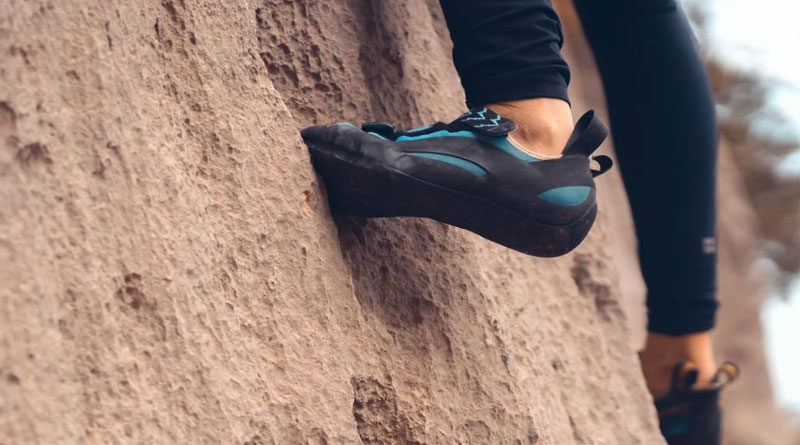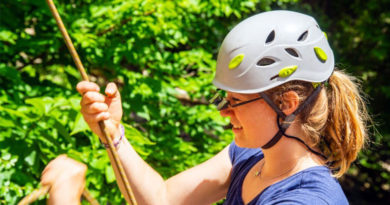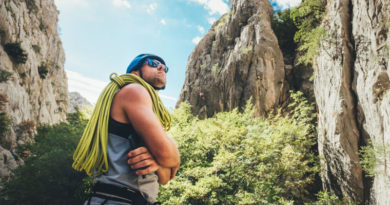9 Reasons Your Climbing Shoes Are Hurting You
Climbing shoes are not supposed to hurt excessively. While some discomfort is to be expected, particularly when breaking in a new pair of climbing shoes, your climbing shoes should not cause you any significant pain. A properly fitted pair of climbing shoes should feel snug and secure without pinching, squeezing, or creating hot spots.
It’s important to remember that everyone’s feet are different, and what works for one person might not work for another. Furthermore, different types of climbing shoes have different fits and functions. Aggressive, downturned shoes designed for steep sport climbing, for example, may fit differently and feel more uncomfortable than a flatter, more all-purpose shoe.
If your climbing shoes are causing you significant pain or discomfort, something is wrong. Consider trying a different size or style of shoe, or seeking advice from a professional at your local climbing gym or outdoor store.
In this blog post, I’ll explore these reasons and offer tips for improving your foot placement to avoid discomfort on the wall.
1. Sizing Issues
One of the most common causes of climbing shoe discomfort is sizing issues. Climbing shoes that are too small can pinch your toes, cause hot spots, and even cut off circulation. Conversely, if your shoes are too big, they will feel sloppy and will cause your foot to slide around inside the shoe.
Several factors must be considered to ensure that your climbing shoes fit properly. To begin, keep in mind that climbing shoes are typically designed to fit snugly, as a tight fit can aid in your control and sensitivity on the wall. Your shoes, however, should not be so tight that they cause pain or discomfort.
Improper-fitted shoes can also cause discomfort and pain in the big toenail due to repeated trauma. To prevent pain, you should choose shoes with a roomier toe box, ensure a proper fit, and wear socks or padding. Severe or persistent pain should be treated by consulting with a doctor or podiatrist.
2. Lack of Break-in Time
When you first purchase a new pair of climbing shoes, they can feel stiff and uncomfortable. This is because climbing shoes are designed to be tight-fitting, and they need time to mold to the shape of your foot. Over time, as you wear your shoes and climb in them, they will begin to loosen up and conform to the contours of your foot, becoming more comfortable.
The time required to break in climbing shoes varies depending on the type of shoe and the materials used in its construction. Leather shoes, for example, stretch and mold more easily than synthetic shoes, requiring less break-in time. Aggressive shoes with downturned toes and tight fits, on the other hand, may take longer to break in than flatter, all-purpose shoes.
Start by wearing your climbing shoes around the house or on short walks to help them mold to the shape of your foot. You can also wear them while doing light climbing or bouldering to help them stretch and conform to the shape of your foot. Wearing your climbing shoes for extended periods of time can cause discomfort and blisters until they have fully broken in.
Allowing your climbing shoes enough break-in time will result in a more comfortable and enjoyable climbing experience. If you’re still experiencing pain or discomfort in your shoes after breaking them in, it might be time to try a different size or style.
3. Improper Foot Placement
Proper foot placement is crucial in climbing. It allows you to maintain balance, generate power, and minimize strain on your hands and arms. When wearing climbing shoes, it’s important to pay attention to how you’re placing your feet on the holds, as improper foot placement can lead to discomfort or pain in your shoes.
One common mistake climbers make is placing their feet too far forward in the shoe. This can cause your toes to curl and scrunch up inside the shoe, leading to discomfort or even pain. To avoid this, try to place the ball of your foot in the center of the shoe, with your toes relaxed and spread out.
It’s also important to consider the angle of the hold when placing your foot. For example, if you’re climbing on a steep overhang, you may need to use the front of your shoe to hook onto the hold, while keeping your heel down to maintain balance. On flatter holds, you can place your foot more squarely in the shoe to maximize surface area and maintain stability.
4. Aggressive Shoe Design
Aggressive shoe design is a style of climbing shoe that is characterized by a downturned toe and a tight, snug fit. These shoes are designed to provide maximum power and sensitivity on steep, technical routes, where precise foot placement is crucial. While aggressive shoes can be highly effective for advanced climbers, they can also be uncomfortable or even painful for some users.
The downturned toe of an aggressive shoe is designed to provide a more natural and efficient angle for pushing off small holds and edges. This can provide a significant boost in power and precision, but it can also put more pressure on the toes and the front of the foot. The tight fit of aggressive shoes can also cause discomfort or pain, especially if the shoes are not sized correctly or if they are worn for extended periods of time.
If you’re considering purchasing aggressive climbing shoes, it’s important to keep in mind that they may not be the best choice for all types of climbing. If you primarily climb on flatter, less technical terrain, a more all-purpose shoe may be a better choice. It’s also important to consider your own foot shape and sensitivity when selecting climbing shoes. If you have wider feet or are prone to foot pain or discomfort, an aggressive shoe may not be the best fit for you.
5. Overuse
Overuse is a common cause of discomfort or pain in climbing shoes. Climbing shoes are designed to be tight-fitting and snug, but wearing them for extended periods of time or using them too frequently can lead to discomfort or even injury. Overuse can also cause the shoes to break down more quickly, reducing their effectiveness and lifespan.
One issue that can arise from the overuse of climbing shoes is the development of blisters or hot spots on the feet. This is particularly common in areas where the shoe is rubbing against the skin, such as around the toes or on the heel. Blisters can be painful and can make it difficult to continue climbing.
Overuse can also cause the rubber on the sole of the shoe to wear down more quickly. This can reduce the shoe’s ability to grip onto holds, making it more difficult to climb effectively. Worn-out shoes can also lead to an increased risk of slipping or falling on the wall.
To avoid overuse, it’s important to allow your climbing shoes time to rest and recover between sessions. Avoid wearing your shoes for extended periods of time, and try to rotate between multiple pairs of shoes if possible. You can also use products such as foot powder or blister pads to reduce the risk of blisters and hot spots.
6. Improper Fit for your Foot Shape
Improper fit is a common cause of discomfort and pain in climbing shoes and can be particularly problematic if the shoe does not match the shape of your foot. Climbing shoes come in a variety of shapes and sizes, and choosing the right fit is essential for both comfort and performance.
If your climbing shoe does not match the shape of your foot, it can cause pressure points, blisters, or other forms of discomfort. For example, if you have a wider foot, a shoe that is too narrow can cause your toes to scrunch together, leading to discomfort or even pain. Similarly, if you have a high arch, a shoe that is too flat may not provide enough support, leading to strain on the muscles and ligaments in your foot.
To ensure a proper fit, it’s important to consider both the length and width of your foot, as well as its overall shape. You may need to try on several different styles and brands of shoes to find the one that matches your foot shape the best. It’s also important to consider the intended use of the shoe, as different styles may be better suited for different types of climbing.
7. Tightening your Shoes Too Much
Overtightening your climbing shoes can cause discomfort, pain, and even injury. While climbing shoes should fit snugly, over-tightening them can cause pressure points, restrict blood flow, and put undue strain on your feet and toes.
Toe knuckle pain is a common issue experienced by climbers when wearing tight-fitting climbing shoes. The pain is caused by pressure exerted by the shoes on the knuckles of the toes. The shoes are designed to be tight-fitting with a narrow and pointed toe-box which can exacerbate the pain.
To prevent toe knuckle pain, choose shoes with a wider and more rounded toe box, stretch and massage your toes, try different lacing techniques, adjust the fit of your shoes, wear socks, or use padding. Severe or persistent pain should be treated by consulting a doctor or podiatrist who may recommend rest, physical therapy, or other treatments.
8. Inadequate Foot Care
Blisters and hot spots are two common problems that can result from poor foot care. These are caused by friction between the shoe and the skin and can be extremely painful if left untreated. Blisters can make climbing difficult and can lead to infections or other complications.
Inadequate foot care can also lead to the development of foot odor or fungal infections. Climbing shoes can trap sweat and moisture, fostering bacterial and fungal growth. This can result in unpleasant odors, itching, or other symptoms that impair your climbing performance.
It is critical to practice good foot hygiene and care in order to avoid these problems. To reduce the risk of infection, keep your feet clean and dry, wear clean and dry socks, and use products such as foot powder or anti-fungal sprays. To reduce friction and pressure on your feet, you may need to adjust the fit of your climbing shoes or use additional padding or support.
9. Underlying Foot Conditions
If you have an existing foot condition, such as plantar fasciitis, flat feet, or bunions, the tight-fitting and rigid design of climbing shoes can exacerbate these issues and cause additional discomfort or pain. For example, if you have plantar fasciitis, the tight-fitting and rigid design of climbing shoes can put additional pressure on the plantar fascia, leading to pain and inflammation. Similarly, if you have flat feet, the lack of arch support in climbing shoes can cause pain and discomfort in the arches and heels.
Bunions, which are bony bumps that develop at the base of the big toe, can also be aggravated by climbing shoes. The narrow toe box in climbing shoes can put pressure on the bunion, leading to pain and inflammation.
If you have an underlying foot condition, it’s important to talk to your doctor or a podiatrist before wearing climbing shoes. They can help you determine if climbing shoes are appropriate for your foot condition, and can recommend modifications or additional support to help you climb more comfortably and safely.
In some cases, custom orthotics or specialized footwear may be necessary to provide the necessary support and cushioning for your foot condition. By addressing underlying foot conditions, you can avoid the discomfort and pain that can arise from wearing climbing shoes, and climb more effectively and with greater comfort.
Conclusion
Climbing shoes are an essential piece of gear for any climber. However, they can also cause discomfort and pain if not used properly. In this article, I have explained nine reasons why climbing shoes can hurt and provided tips on how to prevent this discomfort. From sizing issues and lack of break-in time to aggressive shoe design and overuse, it is important to understand the potential causes of pain and discomfort in climbing shoes. By taking steps such as choosing the right shoe size, breaking in shoes before use, and practicing proper foot care, you can minimize the risk of injury and enjoy a more comfortable climbing experience. With these tips in mind, you can climb with confidence and comfort, reaching new heights on the wall or outdoors.




